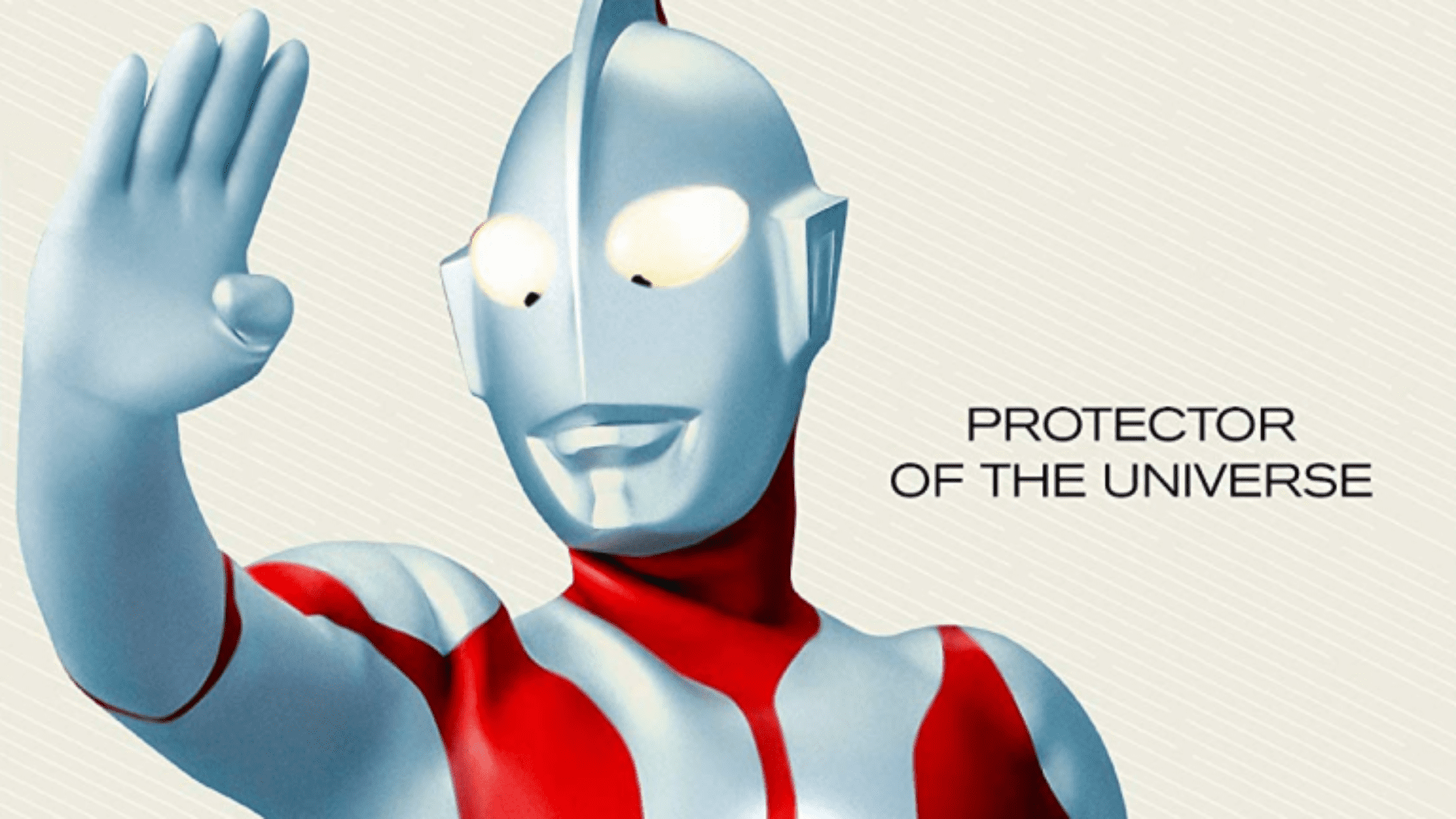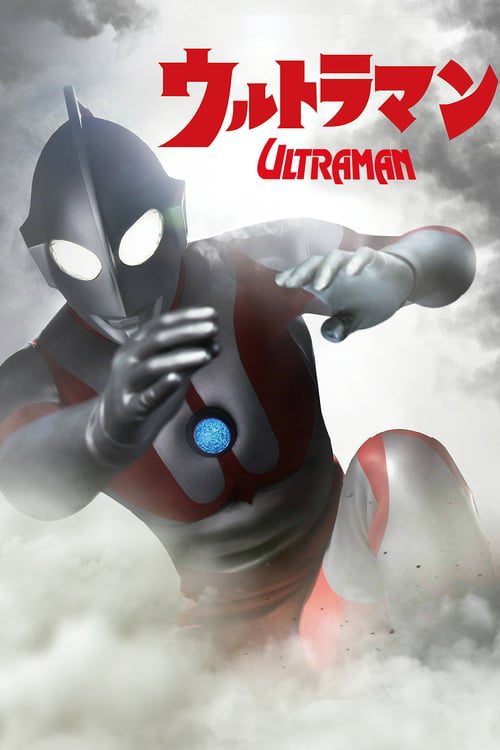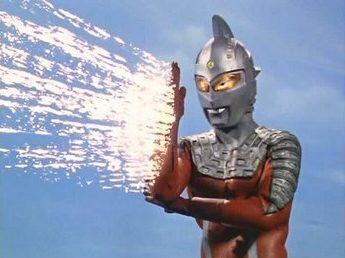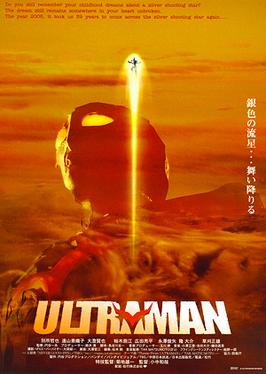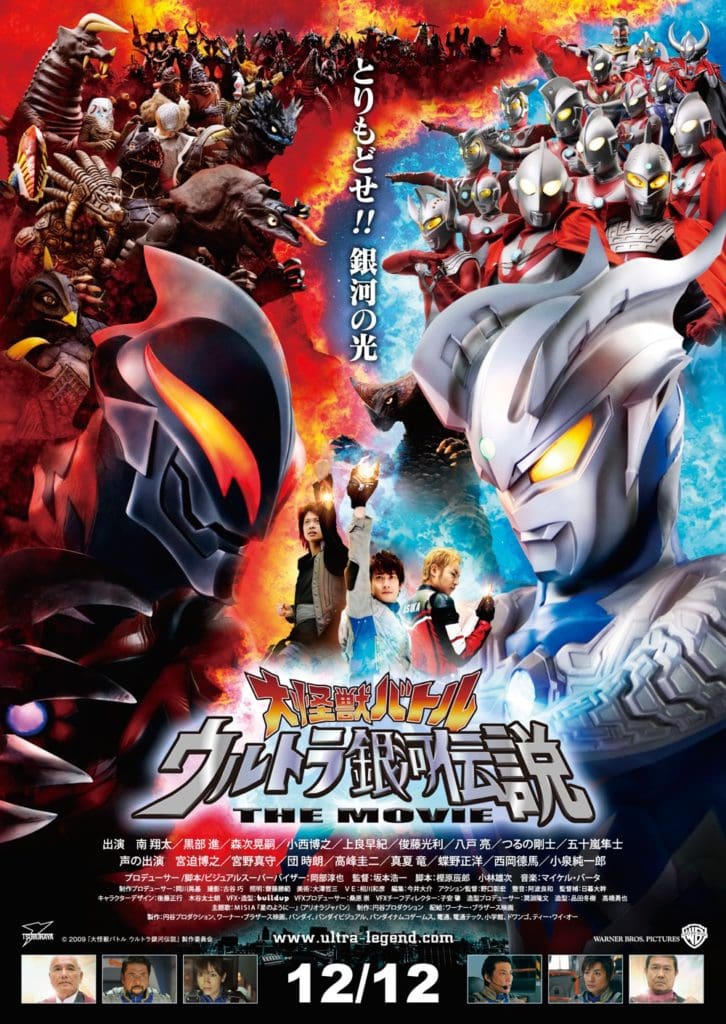SHU-WATCH! It has never been a better time to be an Ultraman fan. Franchise creators Tsuburaya Productions have finally settled their legal troubles with a fraudulent company that claimed foreign ownership rights over the series and with that we’re getting not only official simulcast of the latest series, Ultraman Z, but here in the United States, we’re getting the various shows and movies released on both streaming and Blu-Ray, with plans to release the entire franchise over time.
Created in 1966 by Eiji Tsuburaya (the special effects genius who worked on the original Godzilla films), Ultraman was technically the second series in the Ultra series, its predecessor being the Twilight Zone-style Ultra Q. However, when the superhero series debuted, it became a massive hit, setting off the Japanese superhero boom and being an icon of the Tokusatsu (Special effects) genre of Japanese television and film. Throughout the franchise, the constant theme of hope and perseverance drives the heroes and fans onwards. That said, the sheer volume of media can be an intimidating wall for newcomers (Ultraman currently holds the Guinness World Record for most spinoffs to a television series). Ideally, just about all the major entries are written in a way for new fans, young and old, to get into. Knowing where to start or knowing what aspect of the franchise you may like more than other can be tough but that’s exactly what I’m here for. I’ve been a fan of this franchise since I was a kid, and I’ve dived back in many times in my life, so I have strong opinions about it.
Here are the ten shows and movies that I believe work as entry points for newbies, divided up by era/focus and chosen based on their individual quality. Let’s go!
The Classic Era (AKA the Showa Era AKA the Ultra Brothers Era)
In the original era, running from 1966 to 1980, these series followed each Ultra hero, and eventually built on the larger universe. Much like classic Star Trek or Doctor Who, while the visual effects are of their time, often the writing and innovations became iconic and major parts of the future franchise. If you enjoy these, check out the rest of this era.
Ultraman
Summary: The SSSP (Science Special Search-Party) is an organization that investigates strange phenomena around the world. On one such mission, one of their members, Shin Hayata, crashes into a glowing red ball descended from space in pursuit of a similar blue ball. The blue ball contains a giant monster called Bemular, while the red ball has an intergalactic hero in pursuit of it, Ultraman. To save Hayata’s life, Ultraman bonds with him. After dealing with Bemular, Hayata and Ultraman remain joined, and whenever the SSSP finds themselves up against a major threat, Hayata only needs to slip away and activate his Beta Capsule to transform into Ultraman.
Why it’s here: Naturally, the original show is a great starting point. While the series is very episodic and formulaic, it is easy to jump into any episode. Plus, it’s enjoyable watching how the visual effects, costumes, storytelling, and cinematography evolved during its 39 episodes. While the main characters don’t really develop over the series, they are still fun. Not only would Hayata and Ultraman become icons, frequently returning throughout the franchise and always influencing new series, but so did the monsters like the Alien Baltan, Alien Dada, Gomora, and Zetton. Can’t go wrong experiencing the start of the franchise.
UltraSeven
Summary: The Ultra Garrison, like their predecessors in the SSSP, is an organization that deals with strange phenomena only with a greater emphasis on fighting threats to humanity. Little do they know that their newest member, Dan Moroboshi, isn’t from Earth. This alien visitor has taken on a human form and joins the UG to defend Earth and, when needed, Dan can transform into the knight-like warrior, UltraSeven. As Dan tries to navigate some of the complexities of protecting humanity, he’ll face some of the universe’s most dangerous creatures, most of whom have designs on conquest.
Why it’s here: Initially, this series wasn’t meant to be tied into the same universe as Ultraman (it would be retroactively made into a sequel), so it stands just as well on its own. While it’s just as episodic, it doesn’t follow a strict formula like its predecessor, allowing for more interesting plots. In fact, the show often delved into some dark territory and featured much stronger character writing (helped by having the main hero being one being instead of two bonded as one). The special effects work is amazing, building on the lessons learned from Ultraman. This combined with amazing and iconic foes (with creatures like King Joe and Electing becoming recurring monsters in the franchise) and some of the most brutal battles to involve men in rubber suits (seriously, the way UltraSeven uses his Eye-Slugger, the fin-like blade on his head, to take down foes is shocking), make for one of the most beloved series in the franchise. If future entries aren’t taking cues from the previous show, they’re taking it from this one, including aspects of both storytelling and hero design. Often, the best Ultra series shows blend both Ultraman and UltraSeven to make use of both their strengths.
Return of Ultraman
Summary: Hideki Go is a young racecar driver who, during a sudden monster attack occurs, suffers fatal injuries while rescuing a young boy. As he lay dying, a new Ultraman appears to him, touched by his sacrifice. The two bond, saving Go’s life and giving the world a new Ultraman to protect it as a new age of monsters begins. Go is recruited into the anti-monster task-force MAT, and has to grow as a hero while he and the new Ultraman face both new and old threats.
Why it’s here: I initially wasn’t going to put this here, especially as it serves as a sequel to both Ultraman and UltraSeven but the reality is that, as I said earlier, the best Ultra shows are a blend of both original series, and Return of Ultraman does that. It combines the superhero formula of the original with the more character-driven and darker writing of its successor. It was also the last Ultra series Eiji Tsubaraya conceived of before his death, and his loss does affect the show with less memorable monster designs (not counting Bemstar, Alien Knackle, and Black King, of course). Return of Ultraman is the final piece of the puzzle that finally allows this to become a full-fledged universe of heroes, with both Ultraman and UltraSeven appearing to team up with our new hero. Yes, he does eventually get his own name (years later) to set him apart from the original: Ultraman Jack.
The Revival Era (AKA the Late 90’s to early 2000s)
Yes, this is a less… defined era. I’m mainly referring to when the show came back after a considerable absence (the last classic show was from 1980 and this period started in 1996). There was a lot of experimentation during this period, with some things becoming new staples of the franchise going forward. That said, the budget during this time wasn’t that great, with series being shot on VHS and some effects using CGI and Chromakey animation aging poorly. So picking an entry to show how good this era required careful consideration. That said, there really was only one answer.
Ultraman Tiga
Summary: In the 21st Century after world peace has been achieved, the Global Unlimited Task Squad or GUTS was formed to investigate the appearances of monsters and alien invaders. All of this is due to Earth entering an age of chaos, as an ancient prophecy reveals. The only hope is a “Titan of Light” to face the coming darkness. Daigo Madoka, one of the members of GUTS investigating the prophecy, finds himself absorbed into a giant statue of the Titan, bringing it to life. Daigo, as it turns out, is both the descendant and reincarnation of the Titan: Ultraman Tiga. Tiga and GUTS will have to face the coming darkness, as something horrible is slowly awakening to end the world.
Why it’s here: Serving as a spiritual remake of the best of the classic era, while freeing itself from the larger continuity, along with more modern writing, Ultraman Tiga is a great entry point into the franchise. Daigo being neither an alien nor a human who bonded with one makes him one of the more relatable Ultramen due to his having to learn how to use his new powers. Ultraman Tiga is just as beloved and iconic as the original and his additions to the franchise, the ability to switch between a balanced, strength, and speed mode, have become major staples of Ultramen going forward. The writing is incredibly good, balancing family-friendly humor with darker and scarier story moments. In fact, one of the screenwriters on this series, Chiaki Konaka, is well-known for doing family-friendly adventures that suddenly cross over into the Cthulhu mythos and yes, that’s definitely the case here.
For those who want something darker and more adult
The appeal of the Ultraman franchise ranges from those who are young who like big superhero battles to adults who like interesting sci-fi. Around 2004, Tsubaraya Productions decided to try to rebrand Ultraman for fans who had grown up, starting the Ultra N project. Two entries were created, and while the darker adult tone didn’t stick around, both have become fan favorites. So of course, if you want to watch some Ultraman without feeling like you’re too old for it, these are your entry points.
Ultraman (2004 movie) aka Ultraman the Next
Summary: First Lieutenant Shunichi Maki is an F-15 Eagle jet pilot for the Japan Air Self-Defense Force (no acronym because this is a real Japanese military group), who is quitting his dream job to spend more time with his wife and sickly son who may be terminally ill. On his last mission, while investigating an unidentified flying object, he crashes his jet into a massive glowing red sphere. He survives with no ill effects, except for persistent dreams of a glowing giant figure, and takes up a job as a tour guide pilot. Following this event, the government abducts him, suspecting of being infected with an alien monster like another man, codenamed Beast The One, who has killed and consumed several humans and animals to grow and mutate. Maki, faced with a horror he couldn’t imagine and torn between his fear of what’s happening to his body, his desire to spend what time he can with his son, and his sense of right, has to master the power growing within him to face the monster, prove his innocence, and save the world.
Why it’s here: Taking the original Ultraman’s origin, expanding it to a movie-length production, and then deconstructing its tropes is a brilliant idea. The suit designs in this one emphasize the potential horror involved with alien monsters and possession, with the Ultraman designs especially giving it an alien and organic look. Being a movie allows it to be watched and enjoyed in a single sitting showing the potential of the franchise, and the acting and writing of it as a sci-fi horror adventure is sure to appeal to older viewers. While it may come off as darker than previous entries, the theme of hope and perseverance stands strong.
Ultraman Nexus
Summary: Kazuki Komon works as a professional rescue services man. One day, he receives a sudden transfer to a secret government group called TLT (Terrestrial Liberation Trust), specifically their combat branch, the Night Raiders. The Night Raiders covertly hunt and eliminate alien monsters that murder and eat humans, called Space Beasts. The idealistic Komon finds his beliefs and values constantly challenged by both the monsters and his own teammates, and he finds himself frequently crossing paths with a giant that the Night Raiders consider as big of a threat as the Space Beasts: Ultraman Nexus.
Why it’s here: Subverting the usual tropes of the franchise, Ultraman Nexus is an interesting treat for older viewers. Instead of episodic and formulaic, its storyline is character-driven and plays out over story arcs. The monsters are far more nightmarish, and the collateral casualties are gruesome. Rather than just being accepted by the local investigation/military group, Ultraman Nexus is viewed with suspicion. In one of the most radical twists on the formula, the main human hero, Komon, is not Ultraman Nexus. This gives us a human witness to the insanity of the show while building a mystery over just what Ultraman Nexus is. This is one of the darkest entries in the franchise, with Komon getting put through the emotional wringer by the tragedy and horror, and yet hope still persists. If you like dark horror, conspiracy and mystery, and an Ultraman that zigs where others zag, check this one out.
For those who like a crash course
Let’s be honest, some people like diving into the deep end of a franchise, learning backstory and lore as they go. For those people, we have these entries.
Ultraman Mebius
Summary: Ultraman Mebius is a young Ultraman, the first in decades to go to Earth since the original Ultra Brothers left it. Taking the form of human Mirai Hibino, he hopes to learn how to be a better hero like his predecessors. After his first battle causes incredible collateral damage, he realizes he has a lot to learn, joining the new investigation/military group, Team GUYS. As his adventures carry on, he frequently finds himself facing not just new enemies but also older foes of the Ultra Brothers. Thankfully, the Ultra Brothers are more than willing to show up to help him
Why it’s here: Created to celebrate the 40th anniversary of the original Ultraman, not only do we follow Mebius on his own journey to become a better hero, but as it’s the first show to go back to the Classic Era, it works as a great quick intro to the history there, and is helped by several of the original actors returning to reprise their roles, as well as having the first real appearances of the original Ultra heroes in decades. Simple and accessible.
Mega Monster Battle: Ultra Galaxy Legend the Movie
Summary: Ultraman Belial, one of the few Ultramen in the history of the species to have ever fallen to the darkness, has escaped from his prison after millennia of imprisonment. He assaults Planet Ultra, fighting off some of the heaviest hitters in the franchise before stealing the Plasma Spark, the artificial sun that powers the Land of Light and gave birth to the Ultra species, leaving almost all the Ultras frozen as statues and the planet in a new ice age. He plans to create an army of monsters from the Monster’s Graveyard, the resting place of the franchise’s greatest threats. The original Ultraman, UltraSeven, and Ultraman Mebius need to work together with Rei, a member of Zap Spacey who has the power to control monsters and is partnered with the iconic Gomora, to try and stop Belial. Yet, the best hope may be the mysterious Ultra who was exiled and spent years in training: Ultraman Zero.
Why it’s here: While set deep in the lore of the show, the movie does a great job catching new people up with its story. I never saw Ultraman Mebius or the Ultra Galaxy tv series when I watched this, and yet this caught me up enough that I didn’t feel lost. Getting to see Planet Ultra for the first time was epic, as well as its population being made up of just about every Ultraman hero that ever happened up to that point. Both Ultraman Zero and Belial would go on to become modern icons for the franchise, carrying it into the modern-day.
The New Generation Heroes Era AKA the Modern Era
The modern era, or new generation, on principle should anger me. It’s toy-centric, with Ultra heroes basically using toys and trading cards to assume their different forms or transform at all, as well as the seasons being 25 episodes instead of the previous standard of 40 to 50 episodes. Yet, the short length allows for tighter stories, and the toy tie-ins actually help generate enough money that combined with the shorter length means better special effect budgets. These two, in particular, show the best strengths of this period
Ultraman Orb
Summary: Naomi Yumeno has had dreams of a giant of light fighting a monster since she was a child. As an adult, she leads the Something Search People, a group of bloggers that report on strange occurrences. As their world is suddenly assaulted by monsters, they encounter two individuals: Jugglus Juggler, who is in actuality an alien with a dark agenda, and his rival, the wanderer Gai Kurenai, who is secretly Ultraman Orb. Orb has lost his original power and is forced to rely on the cards based on the power of past Ultramen to transform. As Gai gets closer to Naomi, will he be able to regain his lost power and his belief in himself in order to save the world?
Why it’s here: Besides awesome effects and great action, this show hits the right balance of humor and drama. The Something Search People are hilariously in-over their heads all the time, and Gai, despite his goofier moments, is clearly a suffering hero struggling with his past mistakes. Juggler makes for a great antagonist with an actual story arc. While Orb’s forms are fusions of Ultras from the franchise’s history, knowledge of them isn’t necessary to follow the plot here. Orb has been a huge hit with fans around the world and is often recommended from the current era, alongside another.
Ultraman Geed
Summary: 19-year-old Riku Asakura never knew his parents, growing up with a few close friends (one of whom is an alien named Pega) while hiding his incredible physical power. When a sudden monster attack renders him and Pega homeless, they discover an underground base that has been programmed to recognize Riku as its master. Riku finds out that he’s not actually human, but an Ultraman. Given a pair of capsules to help him transform, creating a fusion form, Riku names himself Ultraman Geed and takes down the monster. Rather than being celebrated, the world looks at him with suspicion, because he resembles his Ultraman father: Belial, the evil Ultra. With his new friends by his side, and Ultraman Zero serving as a mentor, Geed has to face the machinations of his evil father and prove that he’s the master of his fate.
Why it’s here: Riku being an absolute rookie and unknowing of what an Ultraman is makes him an ideal hero to learn about the franchise alongside the viewer. His origin sets him as different from just about every hero in the series while building on the strengths of his predecessor, Orb. He’s also a relatable dorky kid and watching him rise up to be the hero he always wanted to be is just heartwarming. Plus, his supporting cast is one of the best this franchise has ever had for both humor and drama. His popularity among fans is why he’s going to join the current series, Ultraman Z, as a major character.
That’s my list. What’s your list? How did you get introduced to Ultraman? Be sure to comment and let us know on social media.
Celebrate Ultraman Day with other fans by going to the official website (there’s a fun broadcast happening at 10 am PT/1 pm EST with special guests throughout) or by checking out the new Ultraman Galaxy Store.

